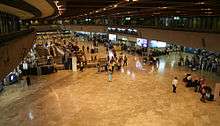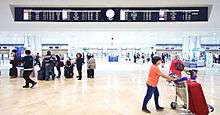Ninoy Aquino International Airport Terminal 1
| Ninoy Aquino International Airport Terminal 1 | |
|---|---|
 | |
| General information | |
| Type | Airport terminal |
| Completed | 1981 |
| Renovated | 2014 |
| Design and construction | |
| Architecture firm | L.V. Locsin and Associates |
| Structural engineer |
Renardet-Sauti Transplan F.F. Cruz Consultant |
The Ninoy Aquino International Airport (NAIA) Terminal 1, in Parañaque, Metro Manila, Philippines, has an area of 67,000 square metres (720,000 sq ft) and having been completed in 1981 is the second oldest terminal at NAIA (after the Old Domestic Terminal, now called Terminal 4) with a design capacity of 4.5 million passengers per year[12] but was further expanded to accommodate 6 million passengers. It currently serves foreign carriers operating in Manila, except for All Nippon Airways, Cathay Pacific, Delta Air Lines, Emirates, KLM, and Singapore Airlines. The detailed designs were adopted by the Philippine Government on 1974 and was subsequently approved by the Asian Development Bank on September 18, 1975. Actual work on the terminal began during the second quarter of 1978. In 1989, a Master Plan Review recommended the construction of two new terminals (NAIA 2 and NAIA 3), as well as many other facility improvements.
History
The development of the Manila International Airport was finally approved through the promulgation of Executive Order No. 381, which authorized the airport's development. In 1973, a feasibility study/airport master plan was done by Airways Engineering Corporation through a US$29.6 million loan from the Asian Development Bank. The Detailed Engineering Design of the New Manila International Airport Development Project was done by Renardet-Sauti/Transplan/F.F. Cruz Consultant while the terminal's Detailed Architectural Design was prepared by Leandro Locsin's L.V. Locsin and Associates.
The terminal reached capacity in 1991, when it registered a total passenger volume of 4.53 million. Since 1991, the terminal has been over capacity and has been recording an annual average growth rate of 11%, but improvements to the airport increased its capacity to 6 million passengers yearly. It has 18 air bridges and services 33 airlines (as of May 2011). Compared with international terminals in other Asian countries, Terminal 1 has consistently ranked at the bottom due to limited and outdated facilities, poor passenger comfort, and crowding (the Terminal has been operating above designed capacity for decades now). In this regard, transport authorities plan to give Terminal 1 a makeover; the plans were approved by President Benigno Aquino III. The makeover and upgrade includes the expansion of the arrival area, addition of parking spaces, and improvement of other terminal facilities.
The Transportation and Communications Department previously announced that as soon as Terminal 3 becomes fully operational, Terminal 1 was eyed by Cebu Pacific with the intention rehabilitating the terminal into an "Airport City" and serve as an exclusive terminal for their aircraft.
Renovation


Terminal 1 started renovation in January 23, 2014 to upgrade and modernize the 32-year-old passenger terminal building and to be finalized and operational by May 2015.Divided into six phases with 40% completion on December 16, 2014, renovations include the installation of buckling restrained braces to strengthen the structural integrity of the building, and a much-needed facelift in the interior design of the terminal. Five international airlines, which are Delta Air Lines, KLM, Emirates, Singapore Airlines, and Cathay Pacific, have transferred to Terminal 3 from August 1 to October 1, 2014 in an effort to decongest the terminal.